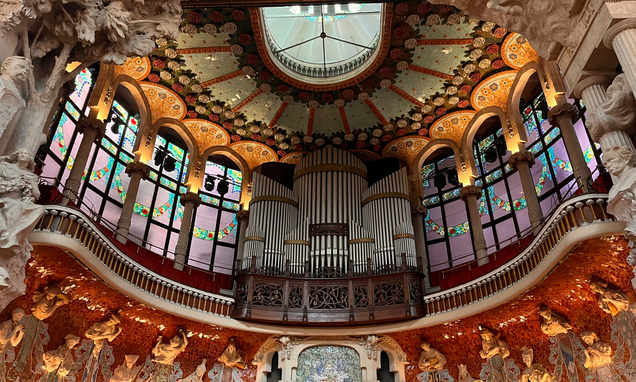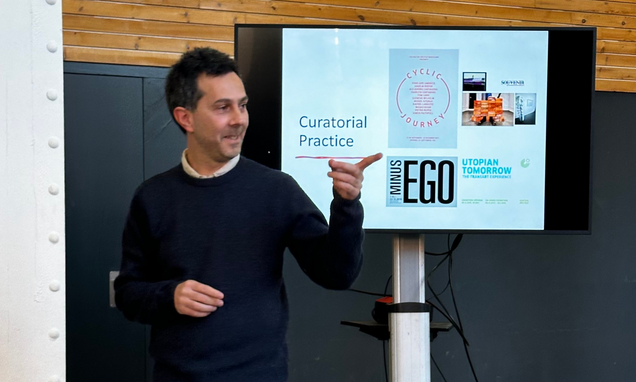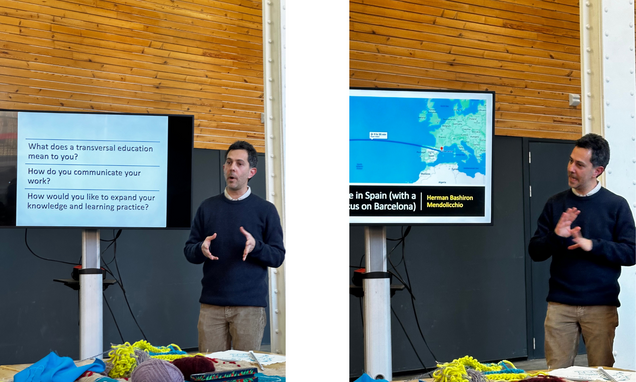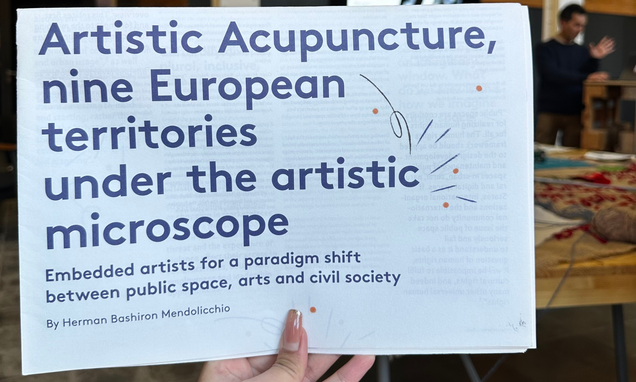The Arts In Barcelona
SPRING 2024

March 16. Liceu’s Messiah
By Ann Li
Today, we visited the Gran Teatre del Liceu to watch a performance of Mozart’s adaptation of Handel’s Messiah (Der Messias), an oratorio commenting on the nativity and resurrection of Jesus Christ. Written in 1741, this is one of the most frequently performed works in Western music. More
March 16. Galleries Tour
By Emma Muminovic.
I love all of them!
As we come to a close of the 2024 Barcelona Arts Administration trip, our group was given the opportunity to tour three diverging galleries: Galeria Rubén Torres, Sala Parés, Arte Vista.
The walls are a rich, dark color and couches are placed underneath artworks from Spanish artists, even several works from Picasso. In the heart of the Gothic Quarter, Galeria Rubén Torres blends his tastes of classical and contemporary artwork to make clients envision their own art collections in their homes. More
March 15. Caixa Forum + lecture from Mr. Ignasi Miro
By Jaclyn Li
Established in 2002, CaixaForum Barcelona stands as an esteemed art museum and cultural hub within the vibrant cityscape, proudly owned by the not-for-profit banking foundation “la Caixa”. More
March 15. Park Güell
By Abrial Bonilla
Today we had the pleasure of touring the historic site of Park Güell. Whether you're into art, nature, or just looking to walk your cute dog, this park has something for everyone. While waiting for entry, we saw a bachelorette party dressed as the Cheetah Girls! It seems they’re hitting up a bunch of Cheetah Girls-inspired locations dressed as the iconic girly pop group, how awesome. Anyways, back to Park Güell. More
March 14. Art is for everyone but not everyone knows it
By Gabriela Reyes Jusino
Nestled within the El Raval neighborhood of the city, the Museo de Arte Contemporáneo de Barcelona (MACBA) offered us a glimpse into how a brand new director and a treasure trove of an archive could create an exhibition celebrating life, resistance, and perseverance. More
March 13. Fabra I Coats II
By Roey
Beneath the lofty ceilings of a grand lobby, we, an eager group, assembled, anticipating an enlightening odyssey into the heart of Spanish art and culture. Professor Herman Bashiron Mendolicchio from the University of Barcelona, with the poise of a seasoned academic and the passion of a true art aficionado, was about to paint the air with the vibrant hues of Spain’s rich cultural heritage. Here, where the past and future of artistic innovation convene, we were not mere spectators but active participants, embarking on a shared journey of discovery set against the bustling backdrop of Barcelona. Welcome to a narrative that promises to expand your intellectual horizons and transform the way you perceive the intersection of art, culture, and education.

Herman adeptly laid out his presentation in a tripartite structure, each part shedding light on a distinct yet interconnected facet of his professional pursuit. Initially, he focused on ‘Research/Academy,’ where he elaborated on his academic endeavors. Next, he navigated through ‘Curatorial Practice,’ showcasing his extensive work in the arts. The final segment, ‘In-between,’ delved into the synthesis of these realms, fostering a cross-disciplinary.
“What does a transversal education mean to you? How do you communicate your work? How would you like to expand your knowledge and learning practice?” Herman asked the participants, guiding the room into a contemplative silence. The attendees, hailing from various disciplines, eagerly contributed, transforming the session into a participatory narrative rather than a monologue.
One of the participants discussed how transversal education meant breaking out of silos, fostering interdisciplinary dialogues, and embracing diverse methodologies. Another reflected on the role of culture in education and how learning practices could be expanded beyond the classroom to encompass global and societal dimensions. Herman listened intently, his face reflecting a genuine interest in each response. He underlined the importance of integrating personal experiences into professional practice, challenging the audience to reflect on how their unique backgrounds inform their approach to learning and collaboration.
Herman emphasizes a transversal approach to education that interweaves various disciplines and cultural perspectives. His work illustrates the importance of networking, sharing knowledge, and engaging in participatory practices, which he demonstrates through his coordination of an international cultural cooperation course. He suggests that learning and teaching by doing can be significantly impactful, particularly in the arts where cross-disciplinary collaboration is vital.

Within his lecture, Herman highlighted notable projects to exemplify his teachings. ‘Artistic Acupuncture,’ for instance, is an endeavor that seeks to address complex issues through brief yet impactful artistic engagements within diverse European locales. These projects serve not only as illustrations of his lecture themes but also as embodiments of participatory art practices that resonate with his transversal approach to education.” Another key project is “Up to Context Learning from the Field,” which resulted from a residency focused on participatory practices in Asia. This initiative led to a publication containing a series of conversations about participatory art practices.
Herman’s curatorial work often intersects with his academic interests, seen in exhibitions like “You Talking Tomorrow,” which focused on future-oriented cultural propositions. His commitment to a transversal approach extends to fostering collaborations beyond the local sphere, as evidenced by his involvement with European projects that encourage walking as an aesthetic and communal practice.
His blend of academic and practical work, combined with his international perspective, and his belief in transversality showcase an educational philosophy that encourages expansive thinking, multidisciplinary interaction, and the meaningful exchange of ideas. His approach challenges conventional educational structures, advocating for dynamic, participative, and transformative learning experiences.

The section on “Art and Culture in Spain (with a special focus on Barcelona)” provided a panoramic view of Spain’s vibrant cultural scene, particularly highlighting the explosion of museum development over the past 50 years following the end of the dictatorship. Spain, now boasting over 1,500 museums, many established in the last two and a half decades, places a significant emphasis on cultural heritage, with a high ranking in UNESCO World Heritage sites.
In Barcelona, Herman underscored the city’s status as a cultural nexus, showcasing a selection of museums and cultural centers like the CCCB and the MACBA, which offer contemporary exhibitions and are pivotal in shaping the city’s artistic landscape. He also touched on Barcelona’s innovative cultural policy of converting old factories into artistic production spaces, a move that has further enriched the cultural fabric of the city.
This insightful overview of Spanish culture, with a lens on Barcelona, invites reflections on the intricate relationship between cultural identity, language diversity—such as the prominence of Catalan in Catalonia—and the arts. Herman’s exploration of the cultural ecosystem offers a narrative of a country that embraces its multifaceted heritage and uses it as a bedrock for continuous growth and artistic expression.
March 13. Fabra I Coats
By Maddie Neiman
In 1925, Fabra I Coats was a textile factory that employed 2,000 workers. Its amenities were progressive for its time; a fire brigade to respond to ever-present safety risks, and a nursery to accommodate the factory’s many working mothers (80% of the factory staff were women). More
March 12. Epica Lab and La Fura del Baus
By Isabelle Fereshteh Sanatdar Stevens
“The future is no longer in one hundred years… It’s in one? Two? Let’s find out,” Fran Iglesias shrugged, shrouded in the light illuminating him from behind, streaming through the floor-to-ceiling windows of the sleek building on the coast of Barcelona. Masts of sailboats in the background, and [redacted] pushed to one side of the open room–part of a confidential exhibition that will open a week after we leave–the setting itself was picturesque, and even if the sun that shone in your eyes didn’t have you squinting, the elaborate exhibitions and performance pieces orchestrated and designed by Epica Lab y La Fura del Baus would. More
March 12. Tour of Palau de la Música Catalana.
By Hannah
Palau de la Música Catalana is a music hall located in the heart of Barcelona, Spain, which is one of the city’s most iconic buildings.
March 12. The Palau Experience
By Brian Beck
The artificial garden set among a previous industrial backdrop was the treat for today. The Palau de la Música Catalana stands unapologetically in its location as a bastion for all forms of music. However, if you happen to be a musician, don't let its warm atmosphere fool you. We were told this is a place of quality, and to be accepted onto its stage means standing where legends have let their sound wash over captivated audiences. With all of the Muses watching from above the stage, the feeling of performing there must be intoxicating. More